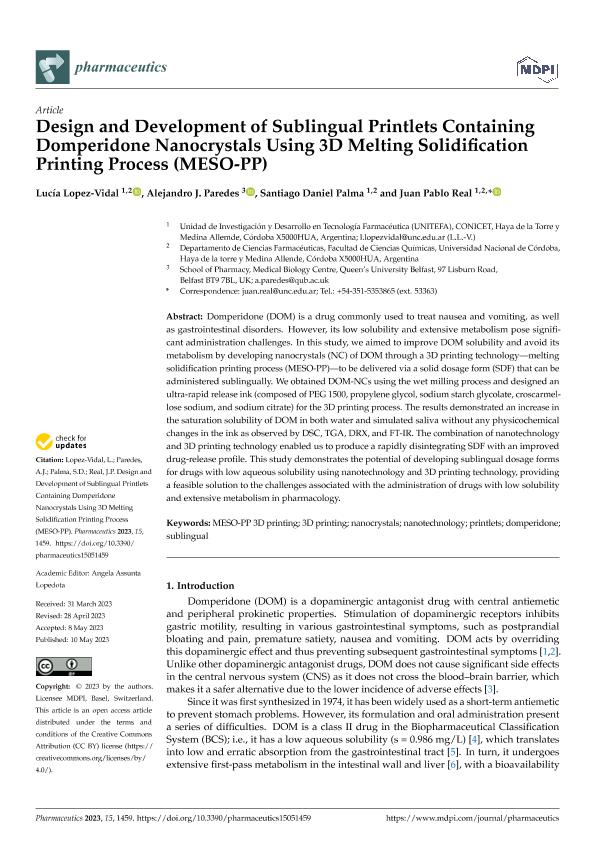Artículo
Design and Development of Sublingual Printlets Containing Domperidone Nanocrystals Using 3D Melting Solidification Printing Process (MESO-PP)
Fecha de publicación:
05/2023
Editorial:
MDPI
Revista:
Pharmaceutics
ISSN:
1999-4923
Idioma:
Inglés
Tipo de recurso:
Artículo publicado
Clasificación temática:
Resumen
Domperidone (DOM) is a drug commonly used to treat nausea and vomiting, as well as gastrointestinal disorders. However, its low solubility and extensive metabolism pose significant administration challenges. In this study, we aimed to improve DOM solubility and avoid its metabolism by developing nanocrystals (NC) of DOM through a 3D printing technology—melting solidification printing process (MESO-PP)—to be delivered via a solid dosage form (SDF) that can be administered sublingually. We obtained DOM-NCs using the wet milling process and designed an ultra-rapid release ink (composed of PEG 1500, propylene glycol, sodium starch glycolate, croscarmellose sodium, and sodium citrate) for the 3D printing process. The results demonstrated an increase in the saturation solubility of DOM in both water and simulated saliva without any physicochemical changes in the ink as observed by DSC, TGA, DRX, and FT-IR. The combination of nanotechnology and 3D printing technology enabled us to produce a rapidly disintegrating SDF with an improved drug-release profile. This study demonstrates the potential of developing sublingual dosage forms for drugs with low aqueous solubility using nanotechnology and 3D printing technology, providing a feasible solution to the challenges associated with the administration of drugs with low solubility and extensive metabolism in pharmacology.
Archivos asociados
Licencia
Identificadores
Colecciones
Articulos(UNITEFA)
Articulos de UNIDAD DE INVESTIGACION Y DESARROLLO EN TECNOLOGIA FARMACEUTICA
Articulos de UNIDAD DE INVESTIGACION Y DESARROLLO EN TECNOLOGIA FARMACEUTICA
Citación
Lopez Vidal, Lucía; Paredes, Alejandro Javier; Palma, Santiago Daniel; Real, Juan Pablo; Design and Development of Sublingual Printlets Containing Domperidone Nanocrystals Using 3D Melting Solidification Printing Process (MESO-PP); MDPI; Pharmaceutics; 15; 5; 5-2023; 1-21
Compartir
Altmétricas




